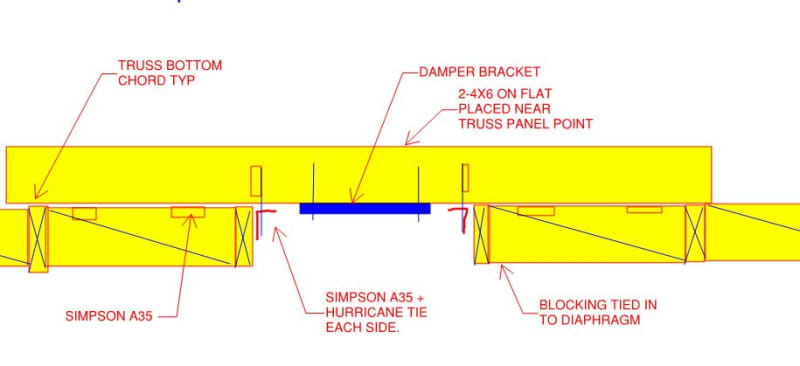MegaStructures
Structural
- Sep 26, 2019
- 376
I have been asked my opinion on the long-term effects of hanging a heavy punching bag from residential trusses.
[ul]
[li]The punching bag will only be hung while in use and stored on the floor at other times[/li][/ul]
[ul]
[li]The punching bag will be attached to a spring-damper system as shown here.[/li]
[/ul]
[ul]
[li]Two trusses will be connected to each-other with additional 2x4 ties and the bag will be hung in the middle of the 2 trusses to avoid torsion of a single lower chord.[/li]
[/ul]
[ul]
[li]Optionally a diagonal knee brace may be added to support to trusses laterally at the location of the bag.[/li]
[/ul]
Of course the plan would also to be to observe the assembly during use to check for any exaggerated deflection, vibration, or otherwise alarming behavior of the trusses while the impact load from the bag is being applied. This step alone should be enough to certify a job well done if no ill effects are felt or seen. I would call this an empirical test of the spring-damper system![[bigsmile] [bigsmile] [bigsmile]](/data/assets/smilies/bigsmile.gif)
This is really more of an opinion thread and not as "professional" as some other posts, but regardless of the means of force application an impact load is an impact load, so let's discuss. If you were asked to design/analyze for an impact load on wood trusses would the combination of the spring-damper system and additional truss bracing be sufficient to protect the existing trusses? Are there any "hidden" concerns, such as nail loosening in the connector plates etc.
“Any idiot can build a bridge that stands, but it takes an engineer to build a bridge that barely stands.”
[ul]
[li]The punching bag will only be hung while in use and stored on the floor at other times[/li][/ul]
[ul]
[li]The punching bag will be attached to a spring-damper system as shown here.[/li]
[/ul]
[ul]
[li]Two trusses will be connected to each-other with additional 2x4 ties and the bag will be hung in the middle of the 2 trusses to avoid torsion of a single lower chord.[/li]
[/ul]
[ul]
[li]Optionally a diagonal knee brace may be added to support to trusses laterally at the location of the bag.[/li]
[/ul]
Of course the plan would also to be to observe the assembly during use to check for any exaggerated deflection, vibration, or otherwise alarming behavior of the trusses while the impact load from the bag is being applied. This step alone should be enough to certify a job well done if no ill effects are felt or seen. I would call this an empirical test of the spring-damper system
![[bigsmile] [bigsmile] [bigsmile]](/data/assets/smilies/bigsmile.gif)
This is really more of an opinion thread and not as "professional" as some other posts, but regardless of the means of force application an impact load is an impact load, so let's discuss. If you were asked to design/analyze for an impact load on wood trusses would the combination of the spring-damper system and additional truss bracing be sufficient to protect the existing trusses? Are there any "hidden" concerns, such as nail loosening in the connector plates etc.
“Any idiot can build a bridge that stands, but it takes an engineer to build a bridge that barely stands.”

